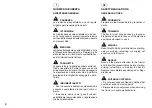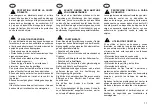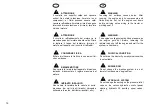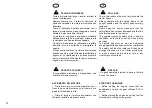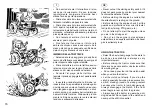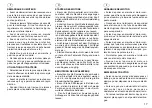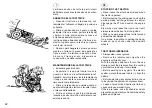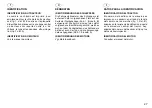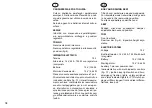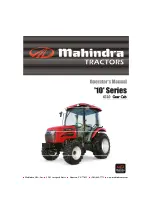
22
I
GB
Verificare anche che tutte le parti rotanti
dell'albero presa di potenza siano ben scher-
mate.
ARRESTO DELLA TRATTRICE
• Quando il trattore è stazionante, non
lasciate mai l’attrezzo collegato in posizione
sollevata.
• Prima di abbandonare il posto di guida
azionate il freno a mano, portate la leva del
cambio in folle, disinnestate la presa di
potenza e arrestate il motore.
Inoltre quando abbandonate il trattore incu-
stodito togliete sempre la chiave d'avvia-
mento dal cruscotto.
• Quando parcheggiate cercate possibil-
mente un terreno in piano, ed applicate il
freno a mano. Su terreno in pendio, oltre a
bloccare il freno a mano, disponete un
cuneo sotto una delle ruote a valle.
MANUTENZIONE DELLA TRATTRICE
• Indossare guanti robusti.
• Asportate il tappo del radiatore solo
quando il motore si è sufficientemente raf-
freddato: a motore fermo, ruotate lentamente
il tappo e scaricate la pressione prima di
rimuoverlo completamente.
• Prima di intervenire su qualsiasi compo-
nente dell'impianto elettrico, staccate il cavo
di massa della batteria.
• Prima di staccare qualsiasi tubazione
idraulica, assicurarsi che nell'impianto non
esista pressione.
STOPPING THE TRACTOR
• Never leave the attachment raised when
the tractor is parked.
• Before leaving the driving seat, pull up the
parking brake, set the gear lever in neutral,
disengage the PTO and switch the engine
off.
Also, when you leave the tractor by itself,
always remove the key from the ignition.
• When you park, always look for flat ground
and put the handbrake on.
On a slope, in addition to putting the hand-
brake on, put a chock under the downhill
wheels.
TRACTOR MAINTENANCE
• Always wear robust gloves.
• Remove the radiator cap only when the
engine is sufficiently cool.
With the engine switched off, turn the cap
slowly to vent the pressure from the cooling
circuit before removing it completely.
• Before working on any part of the electric
system, detach the power cable (+) from the
battery.
• Before detaching any hydraulic line, check
to be certain the system is not pressurized.
• Leaks of pressurized hydraulic fluid can
cause serious personal injury.
If there are leaks, use all suitable accident
prevention equipment such as shields, safety
glasses and gloves.
Summary of Contents for Mars 7.75 EP
Page 2: ......
Page 40: ...38 I GB 3 3 ...
Page 41: ...39 I GB 4 4 ...
Page 42: ...40 I GB 5 ...
Page 43: ...41 I GB 6 ...
Page 45: ...43 I GB 7 2 ...
Page 96: ...94 I GB 11 11 1 ...
Page 97: ...95 I GB 11 2 ...
Page 118: ...116 I GB 15 15 1 ...
Page 119: ...117 I GB 16 2 ...
Page 120: ...118 I GB 16 3 ...
Page 121: ...119 I GB 16 4 ...
Page 130: ...128 I GB 17 17 1 ...
Page 131: ...129 I GB 17 2 ...
Page 153: ......

